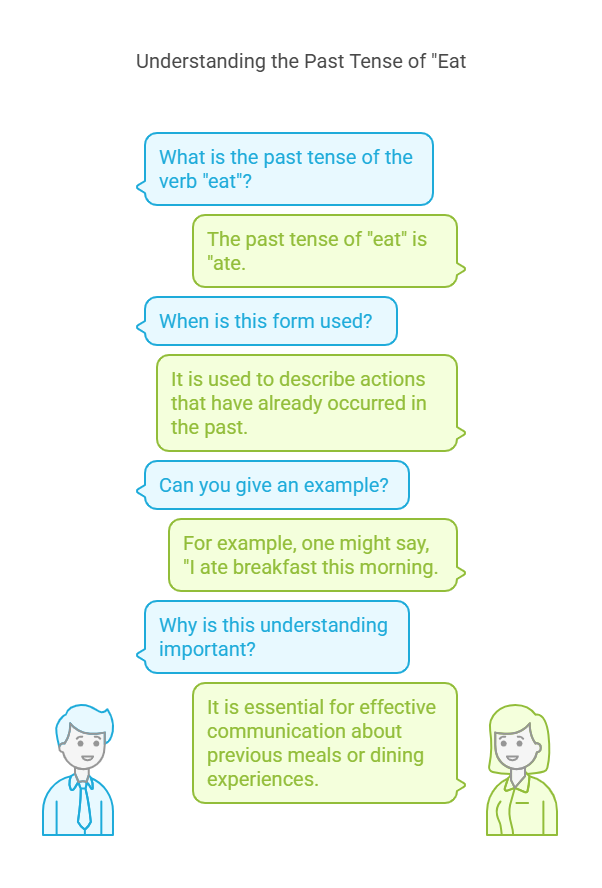Past Tense of Eat Explained: Why It’s Not Eated?

The past tense of “eat” is actually ate.
Understanding the Past Tense of Eat
The Common Mistake: Why People Say Eated Instead of Ate
One of the most common mistakes in English is the use of “eated” as the past tense of “eat.” This error arises because people tend to apply standard pluralization rules, assuming that adding “ed” to the base form “eat” would create the correct past tense. It seems logical at first, but English grammar often defies such simplistic rules. The past tense of “eat” is actually “ate,” a form that doesn’t follow the typical pattern of regular verbs. This confusion is especially prevalent among English learners, and it’s crucial to understand the irregular nature of this verb to avoid common pitfalls.
The Correct Past Tense of Eat: Ate
Why Eat Becomes Ate in the Past Tense
The irregularity of the verb “eat” lies in its historical development. Unlike most verbs in English, which form their past tense by simply adding “-ed” (e.g., “talk” becomes “talked”), “eat” undergoes a vowel change. The past tense of “eat” is “ate,” which is rooted in the verb’s older linguistic forms. This change is part of a broader pattern of irregular verb conjugation in English, where the vowel sound within the word shifts, rather than adding a regular suffix. The irregularity is not arbitrary; it follows historical linguistic rules that have been carried through to modern English.
The Difference Between Regular and Irregular Verbs in English
In English, verbs generally fall into two categories: regular and irregular. Regular verbs follow a straightforward pattern for creating the past tense by adding “-ed” to the base form (e.g., “work” becomes “worked”). Irregular verbs, however, do not follow this predictable pattern and often change their internal structure. “Eat” is an example of an irregular verb, as its past tense is “ate,” which diverges from the regular verb rule. Understanding this distinction is crucial for mastering English verb tenses and improving both writing and speaking accuracy.
Examples of Correct Usage with Ate in Sentences
The past tense “ate” is used to describe an action of eating that has already occurred. For instance, “I ate breakfast this morning,” is a simple and correct way to indicate an event in the past. Additionally, “She ate the entire pizza last night” clearly expresses a past action. Using “ate” correctly helps ensure clarity and maintains the proper structure in both written and spoken English.

Why Eated is Incorrect and How It Came to Be Misunderstood
“Eated” is a commonly used but incorrect form of the past tense of “eat.” This mistake typically arises because people try to apply the regular “-ed” suffix to irregular verbs. Since English speakers are generally taught to add “-ed” for past tense verbs, it’s easy to mistakenly assume that “eat” should follow the same pattern. However, the correct form is “ate,” a result of the irregular conjugation rule that governs this verb. Understanding this distinction is key to avoiding the error of using “eated” in both speech and writing.
How to Use Ate in Context
To use “ate” correctly in sentences, it’s important to follow the standard grammatical structure of subject + verb + object. For example, “She ate lunch at noon” is a proper use of “ate” in the past tense. The past action is clearly described with the correct form of the verb. In questions or negative sentences, “ate” is combined with auxiliary verbs like “did” or “did not” (e.g., “Did you eat?” or “I did not eat”).
Helpful Tips for Remembering Ate vs Eated
Memory Tricks to Help You Remember the Correct Form
One simple trick to remember “ate” instead of “eated” is to associate the word with its past tense by repeating it aloud: “I ate lunch” versus “I eated lunch.” The irregularity of “ate” can also be visualized by imagining someone eating today and someone eating yesterday—just as the action differs, so does the verb form.
Visualizing the Verb Changes with Mnemonics
A mnemonic device like “ate = I ate, it’s a date” can help cement the connection between the correct form and its meaning. Associating “ate” with visual cues, such as an image of someone eating food yesterday, can also help you remember the irregular change.
Practice Exercises for Reinforcing Ate in Context
Practicing with exercises is an effective way to reinforce the correct use of “ate.” Fill-in-the-blank exercises or sentence construction tasks can help solidify the verb’s correct usage. By engaging with these exercises regularly, you can ensure that “ate” becomes a natural part of your language arsenal.
Conclusion: Mastering the Past Tense of Eat for Better Grammar
Mastering the past tense of “eat” as “ate” is a critical part of improving your English grammar. Understanding and practicing the irregular form will enhance your communication skills, ensuring accuracy in both speech and writing. With the right tools, including practice and mnemonic techniques, you can master this irregular verb and continue to elevate your English proficiency.
Source
My name is Khamis Maiouf. I am the creator of the English Teacher Site, dedicated to providing valuable resources and insights for students around the world. With a passion for education and a commitment to helping students enhance their skills, I aim to make English teaching more effective and enjoyable for both educators and students.





